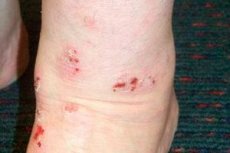Medical expert of the article
New publications
Nodular scabies
Last reviewed: 04.07.2025

All iLive content is medically reviewed or fact checked to ensure as much factual accuracy as possible.
We have strict sourcing guidelines and only link to reputable media sites, academic research institutions and, whenever possible, medically peer reviewed studies. Note that the numbers in parentheses ([1], [2], etc.) are clickable links to these studies.
If you feel that any of our content is inaccurate, out-of-date, or otherwise questionable, please select it and press Ctrl + Enter.

Prurigo nodularis (synonyms: Besnier's prurigo, persistent chronic papular urticaria) is a skin disease characterized by itching, the presence of nodules that usually appear on the arms or legs. The disease was first described by Hyde and Montgomery in 1909 as itchy nodules on the extensor surfaces of the lower extremities.
Causes nodular scabies
The causes of nodular prurigo are unknown. It has been associated with Becker's nevus, linear IgA diseases, autoimmune diseases, and liver diseases. Systemic pruritus is associated with cholestasis, thyroid disease, polycythemia vera, uremia, Hodgkin's disease, HIV, and other immunodeficiency diseases.
It is often found in individuals with dysfunction of the endocrine glands and neuropsychiatric disorders (recent studies (Kieć-Swierczyńska M, Dudek B, Krecisz B, et al. (2006). "[The role of psychological factors and psychiatric disorders in skin diseases]) have refuted the psychiatric cause of the disease. Immune disorders play an important role in the pathogenesis.
Symptoms nodular scabies
The disease begins with intense itching of the skin. Nodules and knots appear on the anterior surface of the shins and the extensor surface of the forearms. They are hemispherical or rounded, very dense, sharply protrude above the skin level, are focally located, symmetrically, their sizes reach up to 1 cm in diameter and more. The elements are initially skin-colored, and then become reddish-brown. Their surface is smooth, often covered with hemorrhagic crusts. Peeling or hyperkeratotic layers may be observed later. Sometimes the surface has a warty appearance. The itching is intense, paroxysmal, intensifies after the development of rashes, which is explained by hyperplasia of nerve fibers in the affected areas of the skin.
 [ 16 ]
[ 16 ]
What's bothering you?
What do need to examine?
How to examine?
What tests are needed?
Differential diagnosis
Differential diagnosis is carried out with the warty form of lichen planus, hypertrophic neurodermatitis, warty tuberculosis, sarcoids, lymphoma, and large-nodular chronic papular urticaria.
Who to contact?
Treatment nodular scabies
It is recommended to follow a hypoallergenic diet. Considering that nodular pruritus often develops in people with diseases of internal organs, the identified pathology is corrected. In mild cases, external means are often used (injection of elements with a 2% solution of novocaine, corticosteroids, diathermocoagulation, irrigation with ethyl chloride).
General treatment consists of prescribing hyposensitizing (30% sodium thiosulfate, 10% calcium chloride or calcium gluconate), antihistamines (tavegil, fenistil, diazolip, pipolfen, etc.), vitamins and other drugs.
If conventional therapy is ineffective and the course is severe, selective photo- or PUVA therapy or oral glucocorticosteroids are prescribed.
In case of severe itching, Fenistil-gel helps as an antihistamine. There are reports on the effectiveness of using local glucocorticosteroids in combination with Elidel.
The effectiveness of the therapy is also enhanced by a combination of Fenistil (in the morning - 1 capsule or drops depending on age) and Tavegil (1 tablet or 2 ml of solution in the evening), externally - Fenistil gel and Elidel.

